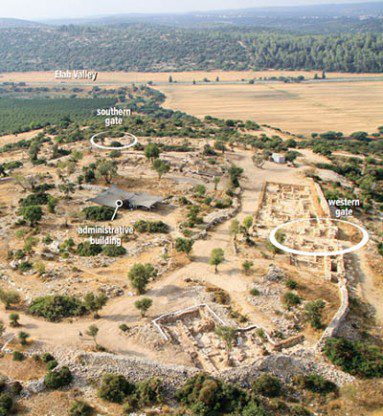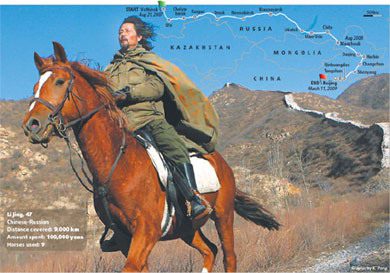Great meals are sometimes found in small little places dubbed “holes in the wall.” This seems especially true in China. But in Israel, a literal hole in the wall in an archaeological site south of Jerusalem is providing a rich meal of information about the controversial era of King David and the United Kingdom. At the site Khirbet Qeiyafa, excavations led by Yosef
Garfinkel and Saar Ganor revealed a fortified city
from the time of King David with evidence of a major administrative center, pointing to a well developed Kingdom of Judah in that era. Especially noteworthy was a surprise discovered by a non-archaeologist accompanying the scholars, Joseph Baruch Silver, a supporter of the excavation. As he looked at the pattern of rocks in the city wall, he realized that he was looking at a previous second gate that had been filled in with rocks. Further investigation proved that he was correct.
A city with two gates, with radiocarbon dating of olive pits pointing to about 1000 B.C., around the time of King David, in a time when no other Jewish city had two gates, could well be the ancient biblical city Sha’arayim, Hebrew for “two gates” (Joshua 15:36; 1 Samuel 17:52; 1 Chronicles 4:31). This is a fascinating find for those interested in biblical history, and
yet another nuisance for those who wish to dismiss the historical
content of the Hebrew scriptures.
The scholars conducting the excavation chose to include Joseph Silver as a co-author in the article they submitted to the Biblical Archaeology Review. The result was a swift rejection because the journal does not welcome attempts to reward amateurs for their financial role by listing them as co-authors.
After some explaining, the article has now been published under the title, “Rejected! Qeiyafa’s Unlikely Second Gate” (membership required for access) by Yosef Garfinkel, Saar Ganor and Joseph Baruch Silver (BAR 43:01, Jan/Feb 2017). A brief overview of the story is available at no cost in the Bible Archaeology Society’s website: see Robin Ngo, “Biblical Sha’arayim: Khirbet Qeiyafa’s Second Gate Discovered” (Jan. 5, 2017), an excerpt of which follows:
“Some scholars
view King David’s kingdom as a simple agrarian society, sparsely
inhabited, with no fortified cities, no administration and no writing,”
write BAR authors Garfinkel, Ganor and Silver. “These
scholars find it very hard to accept the new discoveries at Qeiyafa,
which have completely dismantled these hypotheses.”Indeed, the excavations at Khirbet Qeiyafa show that Biblical Sha’arayim, mentioned in the David and Goliath story in 1 Samuel 17:52, was no ordinary city:
“At the summit of the site, we found a palatial structure that
probably served as the central administrative building for this area of
the Davidic kingdom,” explain Garfinkel, Ganor and Silver. “This, along
with the rest of the site, disproves the early assumption by some
scholars that David was simply a local chieftain who ruled the area
around Jerusalem at most. Excavation showed that more than 200,000 tons
of stone was required to construct this administrative center.”
In the primary article, “Rejected!,” the authors explain the significance of Joseph Silver’s contribution in recognizing the second gate. They cite the letter they wrote to the editor after their initial rejection, addressing the editor’s incredulity that experts would have missed the gate so long only to have an amateur notice it:
“Dear Hershel,” I (Yossi) replied. “To notice a blocked gate is not
so easy. It is a matter of how you look, where you stand, the light,
the vegetation and so on. The fact is that Joey was the first to notice
the second gate of Qeiyafa. He made a great contribution in this
respect.”Our (Yossi’s and Saar’s) first reaction to Joey’s identification of
a “gate” was to dismiss it as an “amateur” discovery: It couldn’t be.
We had already excavated a major city gate on the western side of the
circular wall. Could there be another gate on the southern side of the
wall? No city of this period in Israel had more than one gate.A test excavation, however, confirmed that Joey’s identification was indeed correct. It was
a city gate—a second one. And it turned out that this was the key to
identifying the ancient name of the site: Qeiyafa was Biblical
Sha’arayim, Hebrew for “two gates” (Joshua 15:36; 1 Samuel 17:52; 1 Chronicles 4:31).Qeiyafa lies about 20 miles southwest of Jerusalem, on the summit
of a hill on the northern border of the Elah Valley. This is a strategic
location—on the main road from Philistia and the coastal plain to the
hill country of Judah. Our excavation uncovered a city dated
radiometrically (by carbon-14 tests on 27 olive pits) to Iron IIA (c.
1000 B.C.E.), the time of King David….Of course, our prize find at Qeiyafa was a five-line inscription inked on a broken piece of pottery (an ostracon). While scholars have proposed several different decipherments of the text, it is clear that this is not simply a commercial text; it is a literary text, reflecting ethical principles, and was penned by a professional scribe.c It also clearly includes the word melekh (king). According to the Hebrew University of Jerusalem epigrapher Haggai Misgav, this is the oldest Hebrew inscription ever discovered.
Kudos to this team for terrific work and for strengthening our appreciation of the reality of the Kingdom of David.










